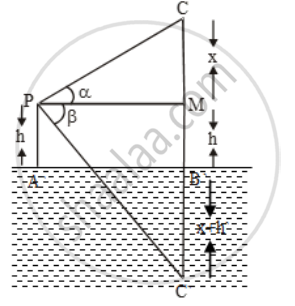Advertisements
Advertisements
Question
If the angle of elevation of a cloud from a point h metres above a lake is α and the angle of depression of its reflection in the lake is β, prove that the height of the cloud is
`\frac{h(\tan\alpha +\tan \beta )}{\tan \beta -\tan \alpha }`
Solution
Let AB be the surface of the lake and let P be a point of observation such that AP = h metres. Let C be the position of the cloud and C´ be its reflection in the lake.
Then, CB = C´B. Let PM be perpendicular from P on CB. Then,
∠CPM = α and ∠MPC´= β Let CM = x.
Then, CB = CM + MB = CM + PA = x + h.

In ∆CPM, we have
`\tan \alpha =\frac{CM}{PM}`
`\Rightarrow \tan \alpha =\frac{x}{AB}`
⇒ AB = x cot α ….(i)
In ∆PMC´, we have
`\tan \beta ={C'M}/{PM}`
`\Rightarrow \tan \beta =\frac{x+2h}{AB}`
[∵ C´M = C´B + BM = x + h + h]
⇒ AB = (x + 2h) cot β ….(ii)
From (i) and (ii), we have
x cot α= (x + 2h) cot β
⇒ x(cot α– cot β) = 2h cot β
`\Rightarrow x( \frac{1}{\tan \alpha }-\frac{1}{\tan \beta })=\frac{2h}{\tan \beta }`
`\Rightarrow x( \frac{\tan \beta -\tan \alpha }{\tan \alpha \tan\beta } )=\frac{2h}{\tan \beta }`
`\Rightarrow x=\frac{2h\tan \alpha }{\tan \beta -\tan \alpha }`
Hence,
Height of the cloud = x + h
`=\frac{2h\tan \alpha }{\tan \beta -\tan \alpha }+h`
`=\frac{2h\tan \alpha +h\tan \beta -h\tan \alpha }{\tan \beta -\tan \alpha }`
`=\frac{h(\tan \alpha +\tan \beta )}{\tan \beta -\tan \alpha }`
